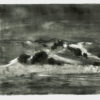“Of all the print processes, [monotype] is the most spontaneous and simple. Its ability to capture a deft stroke of the artist’s hand gives it great appeal to the skilled sketcher, while its simplicity makes it an ideal platform for the sorts of experiments that have intrigued American artists.” – Andrew Stevens, Introduction, American Monotypes in the Baker/Pisano Collection
Singular Impressions:
Fourth National Monotype/Monoprint Exhibition Juror Statement
It was an exciting experience for me to go through the nearly 650 entries to the Monotype Guild of New England’s 2016 competition. I was delighted to discover a very broad array of approaches submitted to what I can no longer call a monotype exhibition. Rather, what I have selected for this exhibition are examples of “singular impressions.” There are many examples of monotype here; however, most of the artists who entered work relied on relief, intaglio, lithography and ink-jet rung through a variety of other process to make one-of-a-kind prints. These, it seems to me, not only broaden the scope of work in this exhibition, but enliven it as well. Including a variety of approaches and showing them together allows viewers to assess what is singular about each of these.
The singular impression has a very long history. I have appropriated the phrase from the fine exhibition catalog “Singular Impressions,” organized by my respected colleague, Joann Moser, in 1997. Dr. Moser’s introduction to Singular Impressions, she cites the work of another fine catalog that was printed for another exhibition “The Painterly Print,” of 1980. These are the seminal catalogs exploring the monotype and its related processes, and are required reading for those interested in this kind of print. I think it is significant that neither exhibition actually calls itself a monotype exhibition. One reason is that the general public has no idea what a monotype is. A more fundamental reason is that it has always seemed counter-productive to constrain the monotype.
The problem isn’t one of definition. We can state pretty succinctly what a monotype is; a print that was composed and executed in wet pigment on a smooth, nonabsorbent plate and printed onto paper before the pigment had a chance to dry. We have a good idea of who the first practitioner was, Giovanni Benedetto Castiglione being the usual suspect. However, those of us obliged to write about it always seem to wander off into related areas. The reason, I think, is that the history of printmaking is full of experimenters inventing things like engraving, etching, lithography, with little respect for the tidy categories that historians like to create. In fact two American monotypists quarreled over who invented the technique at the end of the 19th century, apparently blissfully unaware that it had been practiced more than two centuries earlier, completely mooting their pride of priority.
To see why it is useful to broaden our thinking to cover more than just the monotype, consider the prints of a contemporary of Castiglione; could Rembrandt’s etchings be considered monotypes? They are often singular impressions; the same plate may be wiped carefully but quite differently in the course of two printings to leave more ink in some areas than others and create quite different impressions. In addition, Rembrandt continually revised the plates themselves, re-working the plates of some of his most famous prints over and over again. Given the criteria above, these re-workings are not monotypes. But still, don’t they have some affiliation with the monotype? Doesn’t thinking about monotype as part of the broader spectrum of singular images enrich both the category of monotype and the broader field of printmaking? Clearly, I think so, and that has informed my decisions for this exhibition.
The result is that my selections are intended to reflect the breadth of the field of entries, in terms of their technique. The problem with this is that I have cut works made using similar techniques in the interest of showing the possibilities of the singular impression. I am assailed by the certainty that I have made mistakes, but that is the inevitable consequence of making choices. In my defense, it is also a consequence of seeing prints through the medium of digital photography. (I implore future entrants to be highly critical of their photographic efforts; it is frustrating to zoom into an image and discover only blur.) So those of you who are certain that your work has been unjustly overlooked are undoubtedly correct. However, those of you who feel that exclusion from this exhibition is proof that you should not make art are very wrong; a commitment to art is quite different from a determination to be recognized. The approbation of a trumped-up expert, though flattering, is fleeting. I hope that all of us who share our work with others derive a satisfaction that is much deeper and more fulfilling, lest we end up like Kinkade at Disneyland: with the trappings of success and utterly unfulfilled.
About the Juror:
Andrew Stevens, Curator of the Collection of Prints, Drawings and Photographs at the Chazen Museum at the University of Wisconsin, has published on a variety of subjects from the prints of 18th century printmaker, William Hogarth, to the color woodcut in Japan, Europe and America. He provides unique insights from more than 25 years experience of caring for a collection of 14,000 works on paper and organizing more than 80 exhibitions.





